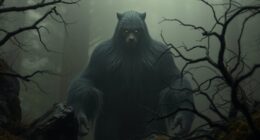Leap Castle's Bloody Chapel reveals a history steeped in betrayal and tragedy. You'll discover that Thaddeus O'Carroll was murdered by his brother during Mass in 1532, marking the start of a violent legacy. Ghostly encounters, eerie noises, and glowing lights suggest his spirit still lingers here. The discovery of an oubliette containing over 150 human skeletons adds another chilling layer to this story. As you wander the castle, you might feel the weight of its dark past haunt you. Keep exploring, and you'll uncover more about the secrets and spirits that continue to mesmerize visitors today.
Key Takeaways
- The Bloody Chapel is notorious for the murder of Thaddeus O'Carroll by his brother Teige during Mass in 1532, symbolizing deep family betrayal.
- Visitors report eerie sensations and ghostly encounters, particularly linked to Thaddeus's spirit still haunting the chapel.
- The recent discovery of the oubliette revealed human skeletons, highlighting the violent history associated with the O'Carroll clan.
- Occult practices by Mildred Darby in the early 1900s intensified the chapel's dark reputation and connection to supernatural elements.
- The chapel's architectural significance, combined with its tragic history, continues to draw tourists fascinated by its haunted legacy.
Historical Overview of Leap Castle

Leap Castle, a formidable stronghold, has a history steeped in violence and intrigue. Originally built around 1250, it served as the stronghold for the O'Bannon clan before the O'Carroll clan seized it in the late 15th century.
This transfer marked the beginning of a tumultuous period, with the castle becoming infamous for its dark events. One of the most notorious incidents occurred in 1532 within the Bloody Chapel, where Thaddeus O'Carroll was brutally murdered by his own brother during Mass.
Ownership shifted in the 1600s to the Darby family, who undertook significant renovations and even concealed treasures during the English Civil War.
However, the castle's fate took a tragic turn in 1922 when it was partially destroyed by the IRA, leading to years of ruin.
During restoration efforts in the 1990s, Sean Ryan discovered an oubliette containing human skeletons, further enhancing Leap Castle's dark reputation.
The castle stands today not just as a remnant of history, but as a chilling reminder of the violent tales that echo through its halls, capturing the imagination of all who hear them.
The Infamous Bloody Chapel

The Bloody Chapel stands as a chilling reminder of the tragic murder of Thaddeus O'Carroll by his brother during Mass, a moment that forever stained the O'Carroll legacy.
Visitors often report eerie sensations and glowing lights, suggesting that Thaddeus's spirit still lingers in the shadows.
This site, with its haunting tales and architectural significance, captures the dark lore of Leap Castle like no other.
Tragic Murder Incident
Amidst the chilling history of Leap Castle lies the Bloody Chapel, where a tragic murder unfolded during Mass in 1532. In a shocking act of betrayal, Thaddeus O'Carroll was killed by his own brother, Teige, leading to a bloody feud that would stain the O'Carroll clan's legacy. Thaddeus bled to death at the altar, forever marking the chapel with a dark tale of familial treachery.
This tragic murder created an atmosphere thick with sorrow and regret, transforming the Bloody Chapel into a site of haunting. Visitors often report eerie sensations, feeling the weight of the chapel's grim history. Thaddeus' spirit is said to linger, illuminating the room with glowing windows at night, a spectral reminder of his untimely demise.
The O'Carrolls' betrayal didn't end with Thaddeus; they were also responsible for the massacre of the McMahon clan, further entangling their name in tales of bloodshed.
Today, Leap Castle stands as one of Ireland's most haunted locations, drawing tourists and paranormal investigators enthusiastic to uncover the secrets of its haunted past. The tragic murder of Thaddeus O'Carroll remains a haunting chapter in this castle's infamous history.
Haunting Spirits Presence
Witnessing the eerie presence of spirits in the Bloody Chapel sends chills down the spine of anyone who steps inside. This infamous site, steeped in the brutal history of the O'Carroll clan, is where priest Thaddeus O'Carroll met his tragic end at the hands of his brother Teige during Mass in 1532. The chapel has since become synonymous with haunting and paranormal activity, drawing thrill-seekers and ghost hunters alike.
Visitors often report spine-tingling sensations and mysterious glowing windows illuminating the chapel at night. Many believe these lights are a manifestation of Thaddeus's ghost, who allegedly roams the space, forever tied to the violent legacy of his family.
The chilling atmosphere echoes with tales of treachery and bloodshed, making the Bloody Chapel a focal point for ghostly encounters. As you explore this haunting location, you might feel a spectral presence lingering in the shadows, reminding you of the dark past that haunts this castle.
The combined energy of Thaddeus O'Carroll and the tumultuous history of the O'Carroll clan guarantees that the Bloody Chapel remains a mesmerizing yet intimidating destination for those drawn to the supernatural.
Architectural Significance and Lore
Nestled within the confines of Leap Castle, the Bloody Chapel stands as a chilling monument to the O'Carroll clan's dark legacy. This Gothic-style chapel, with its haunting architectural features, tells a story of treachery and betrayal, particularly the brutal murder of Thaddeus O'Carroll by his brother Teige during Mass in 1532.
One of the chapel's most notorious features is a trapdoor that leads to an oubliette, symbolizing the secrets buried within its walls. This architectural element not only adds to the chapel's eerie ambiance but also serves as a reminder of the grim history that unfolded here.
Renovations by Jonathan Darby's great-grandson in the 18th century enhanced the chapel's already unsettling atmosphere. Visitors often report an unexplained glow illuminating the space at night, contributing to its reputation for paranormal activity.
The ghost of Thaddeus O'Carroll is said to haunt the altar where he met his tragic end, making the Bloody Chapel a poignant reminder of the castle's violent past. Those who enter can't help but feel the weight of history and the lingering presence of the O'Carroll clan's dark deeds.
Discovery of the Oubliette

In 1922, workers restoring Leap Castle stumbled upon a chilling secret: an oubliette hidden within its stone walls. This dark dungeon served as a grim reminder of the O'Carroll clan's fierce legacy. The discovery revealed a gruesome history, with approximately 150 human skeletons unearthed, many impaled on wooden spikes. The presence of these remains suggested that the castle's brutal practices persisted even into the early 20th century.
The significance of this discovery goes beyond mere historical curiosity. It highlights:
- The O'Carroll family's violent power struggles
- The unsettling reality of their treachery against enemies and even guests
- Leap Castle's status as one of Ireland's most haunted locations
The oubliette's existence and its macabre contents have shaped the haunting tales surrounding Leap Castle. You can almost feel the weight of its bloody past as you wander through its halls, knowing that hidden horrors lurked just beneath the surface.
The chilling revelation about the oubliette not only deepens the castle's mystique but also serves as a haunting reminder of the dark legacy left by the O'Carrolls, echoing through time.
Murders and Betrayals

The haunting history of Leap Castle is steeped in a web of murders and betrayals that have left an indelible mark on its walls.
At the center of this dark legacy stands the Bloody Chapel, where in 1532, Thaddeus O'Carroll was brutally murdered by his own brother, One-Eyed Teige, during Mass. This shocking act of betrayal set the tone for the O'Carroll clan's violent history, characterized by power struggles and treachery.
The sinister atmosphere thickens with the tragic demise of approximately 40 members of the McMahon clan, who perished at a poisoned feast, their spirits now believed to haunt the castle. As you explore the chapel, you can almost feel the weight of these murders echoing through time.
The discovery of an oubliette during restoration work in 1922 unearthed three cartloads of human bones, further revealing the castle's gruesome past.
Every corner of Leap Castle whispers tales of betrayal and bloodshed, ensuring that the haunting legacy of the O'Carrolls lives on, shrouded in mystery and fear.
Haunting Legends and Spirits

While exploring Leap Castle, you might find yourself enveloped in an eerie atmosphere that hints at its haunted legacy. The Bloody Chapel, where the tragic murder of priest Thaddeus O'Carroll occurred in 1532, stands as a chilling reminder of violence and betrayal. His spirit is said to roam the chapel, with visitors often reporting glowing lights and ghostly figures, adding to the site's haunted reputation.
The stories surrounding Leap Castle resonate deeply, weaving a tapestry of fear and intrigue. You may encounter:
- Unexplained noises echoing through the chapel, igniting a sense of foreboding.
- The lingering spirits of the McMahon clan, whose treachery stained the castle's history.
- Paranormal investigations that reveal new accounts of eerie sensations and sightings.
Each visit offers a glimpse into the dark past, urging you to confront the legends that have taken root in this haunted space.
The Bloody Chapel isn't just a site of historical significance; it's a living embodiment of the spirits that refuse to rest. As you walk through its haunting corridors, be prepared for the stories that unfold around you.
Occult Practices and Elementals

Delving into Leap Castle's history reveals a fascinating yet chilling chapter of occult practices, particularly those engaged in by Mildred Darby in the early 1900s. Known for her interest in the supernatural, Mildred attempted to summon an Elemental spirit, a primitive and malevolent ghost that haunted this infamous castle in Ireland.
This dark pursuit resulted in her encountering a thin, sheep-sized shadow, leaving a lingering foul odor reminiscent of decay in its wake.
In 1909, Mildred recounted her terrifying experience with the Elemental, cautioning others about the unpredictable nature of such spirits. Her rituals weren't isolated; they mirrored a broader trend among the gentry at the time, who often dabbled in occult practices.
These activities only amplified the castle's sinister reputation, cementing its status as one of the most haunted locations in Ireland.
The relationship between Mildred Darby's occult endeavors and the gruesome murder that stained the castle's history adds layers to its dark narrative.
With each ritual, she unearthed not just ghosts, but a chilling legacy that continues to draw paranormal investigators and ghost hunters seeking the truth behind Leap Castle's haunting allure.
The Darby Family's Legacy

Throughout the centuries, the Darby family's legacy at Leap Castle has become intricately woven into its haunting history. After the violent reign of the O'Carroll clan ended in 1649, the Darbys took ownership, marking a significant shift in the castle's narrative.
Jonathan Darby, a key figure, infamously hid treasures during the English Civil War, going so far as to murder to guarantee their secrecy.
Later, the family undertook Gothic-style remodeling in the 18th century, blending modern aesthetics with the castle's storied past. However, tragedy struck in 1922 when the castle was destroyed by the IRA, leading to decades of neglect until its restoration in the 1990s.
Mildred Darby's involvement in occult practices during the early 1900s only deepened the connection between the Darby legacy and the ghosts of Leap. This intertwining of history and supernatural elements adds a chilling dimension to the castle's story.
- The Darbys transformed Leap, yet shadows of the past linger.
- Their actions echo through time, influencing local lore.
- Restoration efforts revive a legacy marked by both beauty and darkness.
Visitor Experiences and Tours

At Leap Castle, the chilling atmosphere invites visitors to uncover its dark secrets through guided tours led by owner Sean Ryan.
As you explore the infamous Bloody Chapel, you'll learn about the shocking murder of priest Thaddeus O'Carroll in 1532, said to haunt the room, illuminating it with his ghostly presence. The chapel's eerie trap door, leading to the oubliette, adds an unsettling layer to the experience.
Sean Ryan shares fascinating ghost stories, recounting encounters with spirits like the Red Lady and the playful girls, Emily and Charlotte. Many guests report feeling watched or experiencing sudden drops in temperature, heightening the thrill of your visit.
Whether you're a seasoned ghost hunter or a curious traveler, the tours offer a unique glimpse into the castle's haunted history.
To secure a spot in this popular destination, especially around Halloween, advance booking is highly recommended.
You'll want to be part of the spine-tingling narratives and rich history that make Leap Castle a must-visit for those intrigued by the supernatural.
Don't miss out on this unforgettable journey into Ireland's haunted past!
Leap Castle's Cultural Impact

The haunting tales shared during tours at Leap Castle have cemented its status as a cultural icon in Ireland. This renowned site, infamous for its dark history, draws in ghost hunters and curious tourists alike, keen to uncover the secrets hidden within its walls.
The brutal murder of Thaddeus O'Carroll in the Bloody Chapel is just one example of the gruesome events that contribute to the castle's legacy.
By exploring Leap Castle, you explore a rich tapestry of folklore and supernatural encounters that resonate deeply within Irish culture.
Here's what makes Leap Castle significant:
- Cultural Significance: The castle's stories enrich local folklore, making it a crucial part of Ireland's haunted heritage.
- Ghosts of the Castle: Numerous documented sightings, including those of the Red Lady and spirits of children, continue to captivate the imagination.
- Tourism Magnet: Its eerie atmosphere and dark history attract visitors, boosting local tourism and creating a unique blend of history and mystery.
Ultimately, Leap Castle stands as a symbol of Ireland's fascination with its haunted past and the enduring allure of its ghostly narratives.
Current Restoration Efforts

Restoration efforts at Leap Castle have breathed new life into this historic landmark, making it a fascinating destination for visitors. After Sean and Anne Ryan purchased the castle in 1991, they focused on preserving its historical integrity while addressing the damage inflicted during the IRA destruction in 1922.
Using historical photographs as references, the team meticulously reconstructed various elements, guaranteeing the medieval charm of Leap Castle remained intact.
During the restoration, workmen uncovered an oubliette, revealing a hidden dungeon that contained human skeletons on spikes, which intensified the castle's dark reputation. This discovery not only provided insights into the brutal past of the castle but also captivated the imagination of those intrigued by its history.
Now, Leap Castle is accessible to the public, inviting visitors to explore its many historical features, including the infamous Bloody Chapel where Thaddeus O'Carroll met his demise.
Sean Ryan actively shares the rich history and paranormal aspects of the castle, enhancing visitor engagement and education. The ongoing restoration efforts not only honor Leap Castle's legacy but also guarantee that its dark secrets continue to fascinate generations to come.
Conclusion
Leap Castle's dark history and chilling legends continue to captivate visitors, with reports indicating that over 30,000 people tour the site each year. The haunting stories of the Bloody Chapel and the infamous Oubliette keep the castle's eerie allure alive. As restoration efforts progress, you can witness firsthand the rich tapestry of betrayal, murder, and ghostly encounters that define Leap Castle. Don't miss your chance to explore this remarkable piece of history—who knows what you might uncover?










